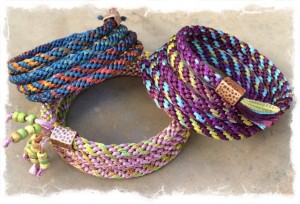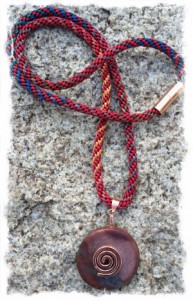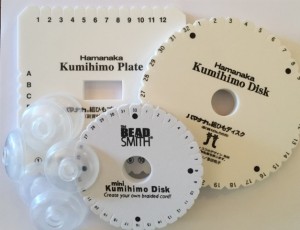Kumihimo is the perfect project to take on a trip. Whether you are traveling by plane, train, boat, bus or simply the passenger in a car, Kumihimo is the perfect portable travel companion. Having just returned from two weeks of traveling in Guatemala, I can speak with experience on the topic of “Portable Projects”. Each year I go with a group to a foreign country and as part of the adventure, I teach Kumihimo. As the teacher, it does my heart good to see my students braiding every chance they get and everywhere they can!

Doing Kumihimo on a boat
Kumihimo is the art of Japanese braiding. The original braids were created by Japanese craftsmen for decorative and practical purposes including a means to fasten and decorate clothing. Kumihimo braids were also an integral part of the unique closures on Samurai armor. The braids are durable and beautiful and have patterns in them that are formed by the placement of the threads as well as the unique movement of the threads. The literal translation of Kumihimo is the “gathering of (kumi) threads (himo)”.

A selection of braids
Today, Kumihimo is very popular among a wide range of age groups. Kumihimo braids are found in bracelets, necklaces and other decorative embellishments. These unique braids can be constructed with a variety of fibers, beads or a combination of beads and fiber. Check out the Kumihimo Gallery Slideshow at http://whataknit.com/2011/01/22/kumihimo-gallery-slideshow/.

Kumihimo necklace
The tools for portable Kumihimo consist of a small, 3/8” thick, sturdy foam disk, plastic bobbins and threads or yarns for braiding. These items are lightweight, unbreakable and since the disks and bobbins are small they can be packed into the corner of a travel bag without taking up much space or weight.

The supplies
Many fibers can be used for braiding including satin cord, yarn, embroidery floss, Perle cotton, ribbon, gimp and silk. 8/0 and 6/0 seed beads are commonly used and many designers are incorporating a variety of novelty beads into their Kumihimo braids. The design possibilities are endless. Braiding patterns are easy to learn and the repetition of braiding is soothing and relaxing which is perfect for a vacation.
The Hamanaka Kumihimo Disk (round) was invented by world renowned Kumihimo Master, Makiko Tada. Makiko explained to me that her original disks were made up of paper (cardboard). She found that many of her students had sweaty hands and by the end of a short braid, the disk would be too wet to be worthy of another braid. She knew that she needed to find a material that would be sturdy yet flexible and withstand moisture. She worked with the Hamanaka company and after testing many materials, the foam disk was developed. Makiko Tada also invented the Hamanaka Square Plate.
There are many disks on the market today. The “original” disk is 6” in diameter and the newer mini disk measures 4.25” in diameter. Both disk sizes have 32 slots and can produce identical braids. The firm slots in the disks keep the threads under perfect tension.

Elmy ,Karen and Dominga in Guatemala
I always have a Kumihimo project ready to go. I have a crocheted shoulder satchel that is my “go-to” Kumihimo bag. In this small bag I keep my Kumihimo disk, 8 to 16 plastic bobbins, a measuring tape and a pair of blunt end scissors. I tuck in some colorful threads and no matter where I am, I have something to keep my hands busy.
Kumihimo tools and materials are compatible with most TSA guidelines which makes Kumihimo a great “airplane” project. In addition, Kumihimo is a nice conversation piece and I meet all sorts of people when I am braiding.
Karen Huntoon, owner of “What a Knit and Kumihimo too!”, has been sharing her love of Kumihimo for many years. She teaches, designs and has a full website catering to Kumihimo. Visit her website at www.whataknit.com where you will find her unique Kumihimo Kits and everything else needed to get started in Kumihimo. She warns, “It’s addicting!” karen(at)whataknit.com